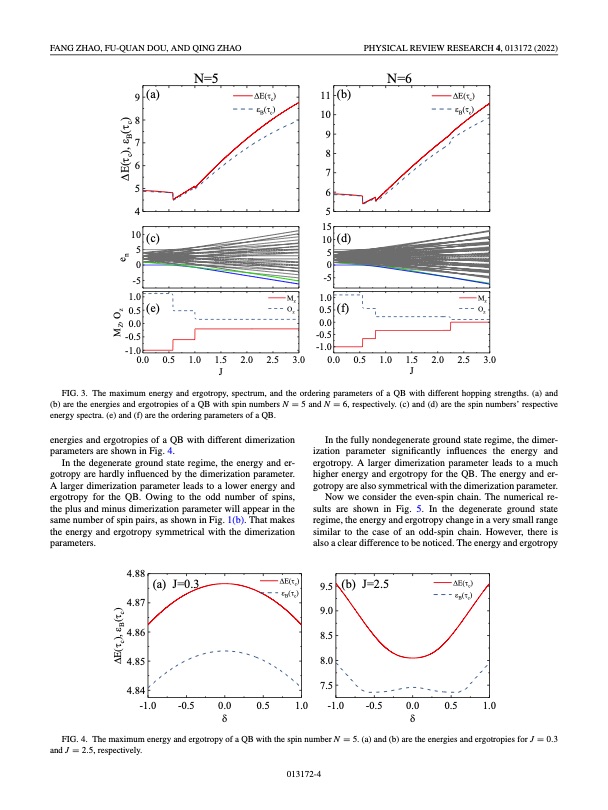
PDF Publication Title:
Text from PDF Page: 004
FANG ZHAO, FU-QUAN DOU, AND QING ZHAO PHYSICAL REVIEW RESEARCH 4, 013172 (2022) N=6 9 (a) 8 7 6 5 9@(c) 11 (b) rB(c) 10 9 8 7 6 9@(c) rB(c) N=5 45 15 10 (c) 10 (d) 5 00 -5 1.0 Mz 1.0 Mz Oz Oz 0.5 (f) 0.0 -0.5 0.5 (e) 0.0 -0.5 -1.0 FIG. 3. The maximum energy and ergotropy, spectrum, and the ordering parameters of a QB with different hopping strengths. (a) and (b) are the energies and ergotropies of a QB with spin numbers N = 5 and N = 6, respectively. (c) and (d) are the spin numbers’ respective energy spectra. (e) and (f) are the ordering parameters of a QB. -1.0 0.0 0.5 1.0 1.5 2.0 2.5 3.0 0.0 0.5 1.0 1.5 2.0 2.5 3.0 JJ energies and ergotropies of a QB with different dimerization parameters are shown in Fig. 4. In the degenerate ground state regime, the energy and er- gotropy are hardly influenced by the dimerization parameter. A larger dimerization parameter leads to a lower energy and ergotropy for the QB. Owing to the odd number of spins, the plus and minus dimerization parameter will appear in the same number of spin pairs, as shown in Fig. 1(b). That makes the energy and ergotropy symmetrical with the dimerization parameters. In the fully nondegenerate ground state regime, the dimer- ization parameter significantly influences the energy and ergotropy. A larger dimerization parameter leads to a much higher energy and ergotropy for the QB. The energy and er- gotropy are also symmetrical with the dimerization parameter. Now we consider the even-spin chain. The numerical re- sults are shown in Fig. 5. In the degenerate ground state regime, the energy and ergotropy change in a very small range similar to the case of an odd-spin chain. However, there is also a clear difference to be noticed. The energy and ergotropy 4.88 4.87 4.86 4.85 4.84 -1.0 -0.5 9@(c) rB(c) 1.0 (a) J=0.3 9.5 9.0 8.5 8.0 7.5 (b) J=2.5 9@(c) rB(c) 0.5 1.0 0.0 0.5 -1.0 -0.5 0.0 qq FIG. 4. The maximum energy and ergotropy of a QB with the spin number N = 5. (a) and (b) are the energies and ergotropies for J = 0.3 and J = 2.5, respectively. 013172-4 5 -5 9E(c), rB(c) MZ, Oz en 9E(c), rB(c)PDF Image | Charging performance of the Su-Schrieffer-Heeger quantum battery

PDF Search Title:
Charging performance of the Su-Schrieffer-Heeger quantum batteryOriginal File Name Searched:
2105-00258.pdfDIY PDF Search: Google It | Yahoo | Bing
Sulfur Deposition on Carbon Nanofibers using Supercritical CO2 Sulfur Deposition on Carbon Nanofibers using Supercritical CO2. Gamma sulfur also known as mother of pearl sulfur and nacreous sulfur... More Info
CO2 Organic Rankine Cycle Experimenter Platform The supercritical CO2 phase change system is both a heat pump and organic rankine cycle which can be used for those purposes and as a supercritical extractor for advanced subcritical and supercritical extraction technology. Uses include producing nanoparticles, precious metal CO2 extraction, lithium battery recycling, and other applications... More Info
| CONTACT TEL: 608-238-6001 Email: greg@infinityturbine.com | RSS | AMP |